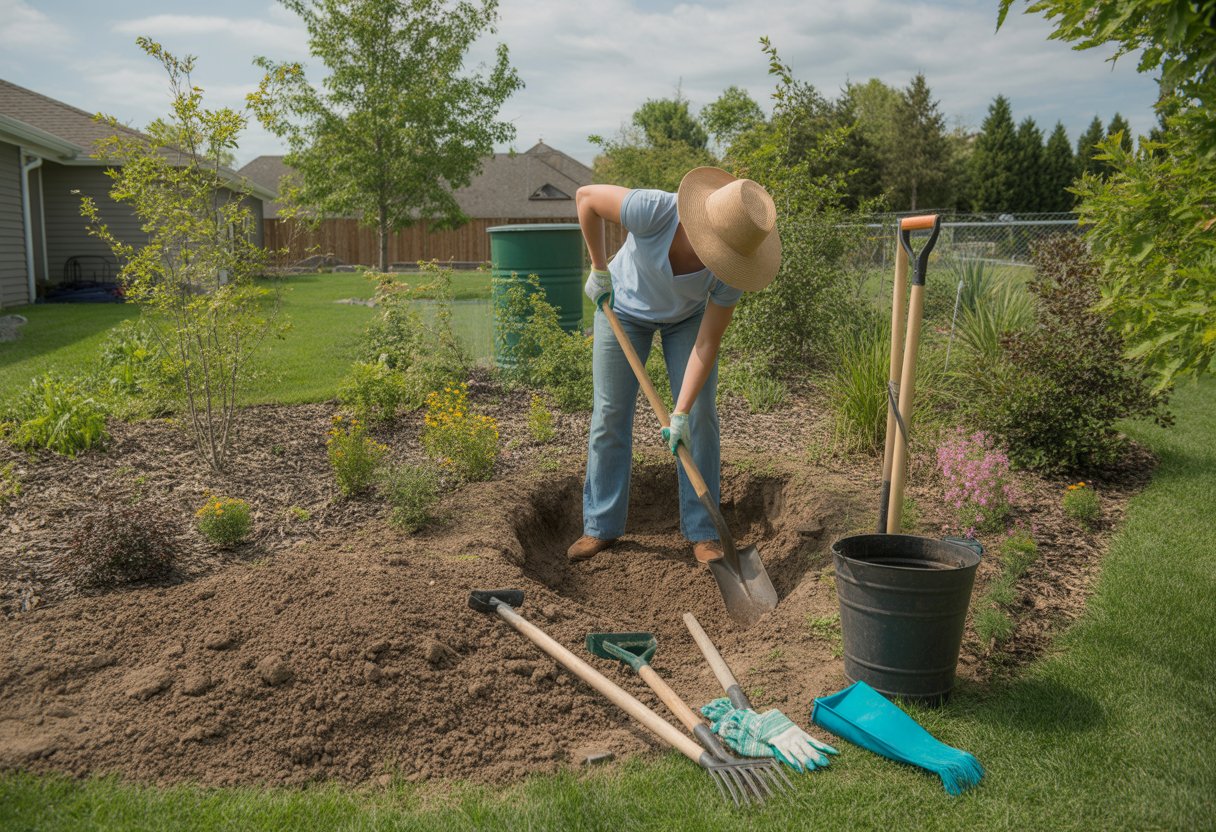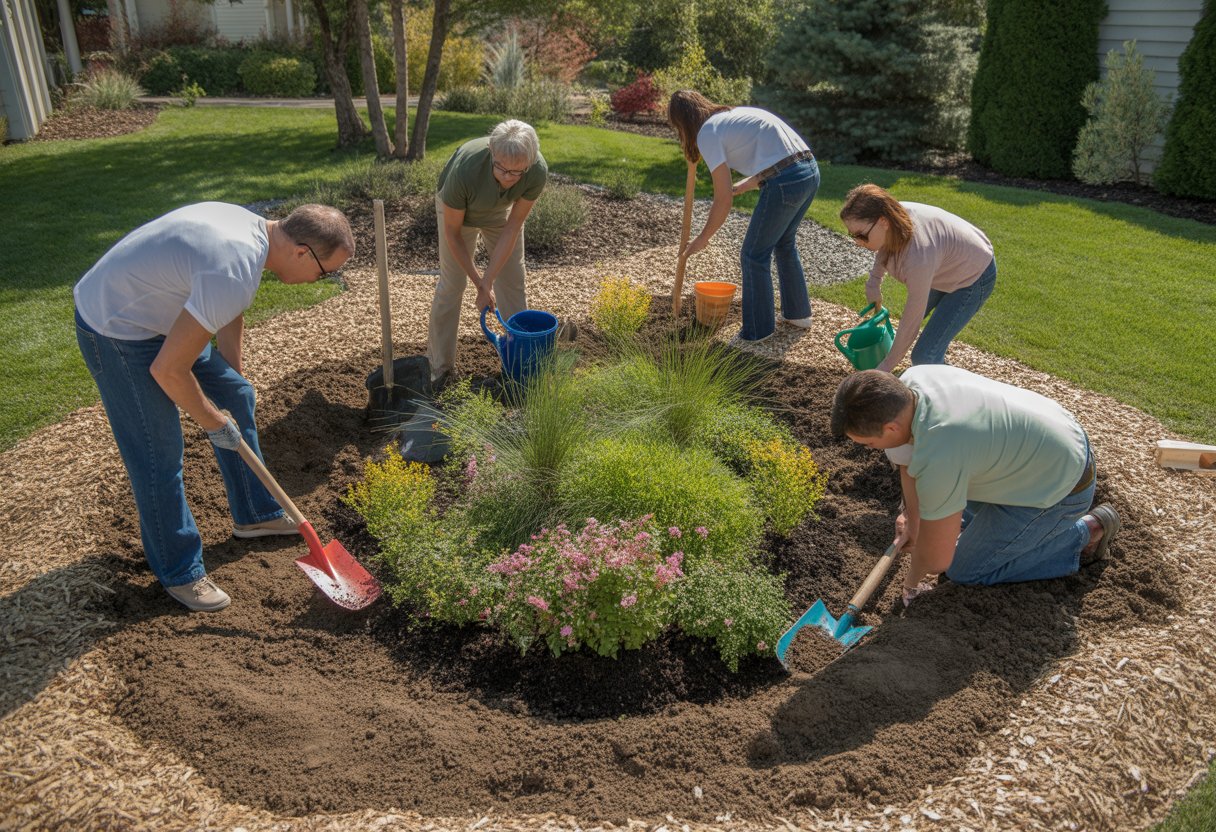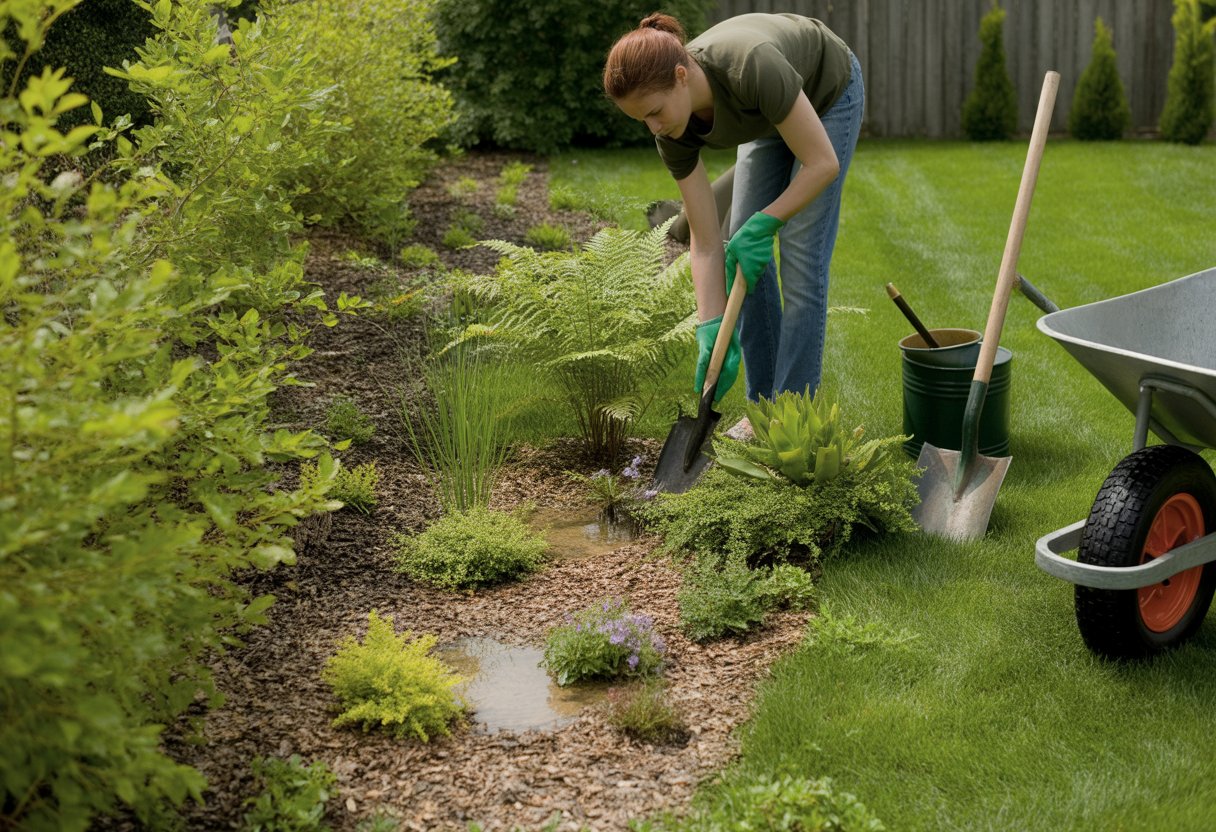How to Start a Rain Garden: A Step-by-Step Guide for Beginners
Starting a rain garden? First, pick a spot where water naturally gathers or runs off from roofs, driveways, or other hard surfaces.
The main thing is to dig a shallow basin that collects stormwater. Use native plants that can handle both wet and dry spells—they’ll help filter out pollutants and manage runoff.

Choosing the right soil mix matters for drainage and plant health. You’ll probably need to amend the soil to help water soak in.
Plan the garden with gentle slopes and contours that direct water efficiently. This helps avoid pooling and erosion.
Rain gardens cut down on water waste and support local ecosystems. They’re a great way to help pollinators and birds right in your yard.
You get practical stormwater management, plus some real curb appeal.
Understanding Rain Gardens
Rain gardens catch and manage stormwater runoff from hard surfaces like driveways or roofs. They let water soak in, trap pollutants, and protect local water quality by filtering runoff before it hits creeks or streams.
What Is a Rain Garden
Think of a rain garden as a shallow, planted dip that collects rainwater from things like driveways and patios. It’s filled with native plants and soil meant to soak up water fast.
Traditional gardens don’t really handle runoff, but rain gardens do. They slow water down and let it seep into the ground, so less of it rushes into storm drains and local streams.
This helps prevent erosion and keeps pollutants from washing away.
Benefits of Rain Gardens
Rain gardens let water soak in instead of rushing into drains. This can help prevent flooding and take some pressure off your local sewer system.
They also trap things like oil, metals, and fertilizer that might get swept up in runoff. That’s a win for water quality.
Native plants in rain gardens attract wildlife and boost biodiversity, especially in cities.
How Rain Gardens Work
Rain gardens intercept runoff from roofs, sidewalks, and driveways. Water collects in a shallow basin, and the right soil and plants soak it up and filter out gunk.
Usually, the water drains into the soil within a day or two, so you don’t get standing water or a mosquito problem. The roots create tiny channels, helping water move down faster.
By slowing down runoff, rain gardens cut down on erosion and reduce peak flow during storms. This helps recharge groundwater and keeps streams cleaner.
Planning Your Rain Garden
Planning a rain garden takes a bit of thought. You’ll want to consider location, size, shape, and how water moves through your yard.
Each of these factors affects how well the garden collects rain and protects your property from drainage headaches.
Choosing the Right Location
Look for a low spot or shallow dip where water tends to collect. Don’t put the garden right next to your house or over a septic system—you don’t want water problems.
Good locations are often below downspouts, driveways, or other places where runoff is focused. Try to keep the garden at least 10 feet from any building.
Sunlight matters. Most rain garden plants like partial to full sun.
If your yard slopes up to 12%, that’s fine. Steeper slopes might need terraces or some extra work.
Sizing and Shaping the Garden
The size depends on how much runoff you’re dealing with. As a rough guide, aim for a garden that’s about 20-30% the size of the area draining into it.
Shape the garden to fit your yard’s contours, usually stretching it along the slope. A round or kidney shape works well to slow water down.
Depth usually falls between 4 and 8 inches. That’s deep enough to hold water without drowning the plants.
A berm (a small ridge) on the lower side helps keep water in the garden for a bit.
Assessing Drainage and Water Flow
Test your drainage by digging a hole about a foot deep and filling it with water. If it drains within a day, you’re good to go.
Map out where water flows from roofs, driveways, and other surfaces. Use swales or direct downspouts into the garden to catch as much runoff as possible.
Skip spots that stay soggy or flood after rain. Make sure your grading lets water pool temporarily without causing trouble nearby.
A well-chosen site keeps water soaking in, supports healthy plants, and stops extra runoff from leaving your yard.
Building and Planting the Rain Garden

Building a rain garden means prepping the soil, picking the right plants, and arranging everything to help pollinators and wildlife. You’ll need to think about drainage and choose plants that look good but also work hard for the ecosystem.
Soil Preparation and Infiltration
Getting the soil right is key. You want water to soak in, not run off.
If your soil is heavy clay, you’ll need to mix in sand and compost to help it drain. Well-draining soil is the goal, otherwise you’ll have puddles.
Dig the basin about 6-12 inches deep. Mix native soil with about half compost to boost nutrients and let water in.
Test by filling the basin with water. If it doesn’t drain in a day, add more compost or expand the garden’s footprint.
Selecting Native Plants
Native plants are tough and low-maintenance because they’re used to local weather and soil. Pick ones that can handle both wet feet and dry spells.
Try native wildflowers like Echinacea or Asclepias. Pair deep-rooted perennials with grasses to keep soil in place.
Mix up bloom times so there’s always something happening in the garden.
Planting for Pollinators and Wildlife
You can really help pollinators by planting a mix of nectar flowers and host plants for butterfly larvae.
Go for shrubs and wildflowers like milkweed and goldenrod, which attract bees and butterflies. Plant in clusters, not rows, to mimic nature.
Add a few evergreens for year-round shelter. It’s a small thing, but wildlife will thank you.
Maintaining Your Rain Garden

Rain gardens aren’t exactly set-and-forget projects. They need regular care to keep plants healthy and water flowing where it should.
Seasonal Care and Upkeep
In spring, clear out debris and add a thin layer of mulch. Check how the soil drains and toss in some compost if it’s getting packed down.
Summer means watering during dry spells, especially for new plants. Stay on top of weeds—they can take over fast.
Come fall, cut back dead stems and rake up leaves so the drainage doesn’t clog. In winter, keep an eye out for erosion or water pooling near the edges.
Solving Common Issues
If water stands around after a storm, your drainage might need work. Loosen compacted soil or add mulch to help water soak in.
Unhappy plants? Check if the soil’s too wet or too dry, and swap out anything that’s struggling.
Handle erosion by adding mulch or groundcovers on slopes. Pull invasive weeds early, before they get out of hand.
Stormwater can bring in sediment that blocks drains, so clear out debris regularly to keep everything running smoothly.
Tips for Low Maintenance
Pick native plants that fit your local rainfall. They usually need less watering and fewer pest treatments.
Group plants that need about the same amount of water. That way, you can water more efficiently without overthinking it.
Spread mulch in layers, about 2–3 inches thick. Mulch keeps the soil damp and holds back weeds, so you won’t be out there pulling them all the time.
Shape your garden with gentle slopes and sturdy edges. This helps prevent erosion and keeps things tidy.
Try using a rain gauge or a basic moisture sensor. You can keep tabs on your garden’s health without running outside every day.
